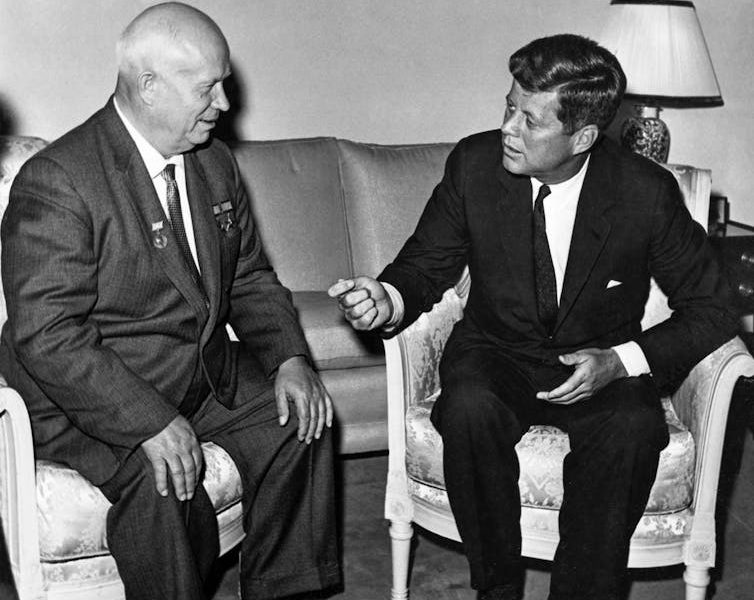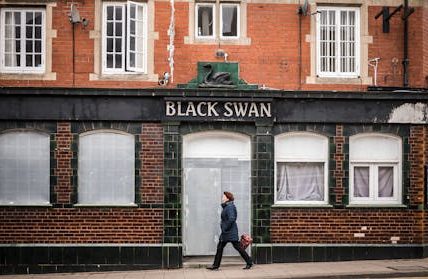Fear built the nuclear bomb – only trust can ensure it is never used again
The world entered its nuclear epoch 80 years ago on August 6 1945. The US dropped an atomic bomb on the Japanese city of Hiroshima, killing between 70,000 and 140,000 civilians by the end of that year.
A stark reminder of this immense destructive power came recently. On August 1, US president Donald Trump announced the redeployment of two submarines – presumably Ohio-class subs carrying ballistic missiles – in response to what he called “highly provocative statements” by Russia’s former president Dmitry Medvedev.
It may have been empty posturing by Trump. But one Ohio-class submarine (the US Navy has 14 in its fleet) carries approximately 90 warheads, each with destructive power many times greater than the bombs dropped on Hiroshima and, three days later, Nagasaki.
As the world remembers the devastation wrought by these bombings, the threat of nuclear conflict remains a persistent threat to humanity.
Frisch-Peierls memorandum
For many years it was believed that building an atomic weapon was not feasible given the amount of uranium-235 required for a bomb. This assumption changed in March 1940 when two refugee physicists – Rudolf Peierls and Otto Frisch, who both worked at the University of Birmingham – produced in secret what became known as the Frisch-Peierls memorandum.
Their memorandum showed that a powerful atomic bomb could be built using only a small amount of uranium-235. What drove Frisch and Peierls was fear that Nazi Germany might build the bomb first.
They wrote: “If one works on the assumption that Germany is, or will be, in the possession of this weapon … The most effective reply would be a counter-threat with a similar bomb. It would obviously be too late to start production when such a bomb is known to be in the hands of Germany, and the matter seems, therefore, very urgent.”
The Frisch-Peierls memorandum was submitted to the British government as a warning. Prime Minister Winston Churchill heeded the message, establishing the Maud committee a month later to investigate the military potential of atomic energy.
It reported in secret in July 1941, urging production of a bomb and Britain’s cooperation with the US in this endeavour. In a now-famous line, the committee said: “No nation would care to risk being caught without a weapon of such decisive possibilities.”
The demonstration of what the atomic bomb was capable of at Hiroshima, and then at Nagasaki, spurred others to follow the committee’s logic. The Soviet Union, fearing a US atomic monopoly, tested its first bomb in 1949. Britain joined the nuclear club in 1952, followed by France in 1960 and China in 1964.
It is widely accepted that Israel had developed nuclear capability by the early 1970s, though it has maintained a position of ambiguity. India and Pakistan became declared nuclear powers in 1998 and North Korea followed in 2006.
While factors such as national ambition and status played a role in proliferation, a key driving force was fear, fear of adversaries achieving a lasting strategic advantage and, in the case of North Korea, an external attack.
Fear’s centrality to the nuclear story is not only in relation to its role as a driver of proliferation. Nuclear fear has also been a key source of restraint. The most dramatic manifestation of this was the October 1962 Cuban missile crisis.
As I have argued elsewhere, shared fear of nuclear catastrophe led the then US president, John F. Kennedy, and his Soviet counterpart Nikita Khrushchev to develop empathy and trust. This was a key factor in the peaceful resolution of the crisis.
John F. Kennedy meeting with Nikita Khrushchev during a 1961 summit held in Vienna.
US Department of State
However, nuclear fear – and the deterrence it makes possible – is a fragile basis on which to safeguard humanity’s future. The world may have avoided the use of nuclear weapons since August 1945 through a combination of prudent statecraft and good luck. But how long is it before some combination of bad luck and reckless risk-taking leads to the use of nuclear weapons once again?
Russian nuclear sabre-rattling over Ukraine and the May 2025 conflict between India and Pakistan, unleashing military force between two nuclear-armed states, are warnings that the ever-present threat of nuclear weapons still hangs over humanity.
In the cold war’s climate of deep distrust and nuclear fear, the US and Soviet Union at least had some shared guardrails and channels of communication. Arms control agreements agreed after the Cuban missile crisis limited superpower competition through the 1960s and 1970s. They continued to restrain US-Soviet competition in the early 1980s.
Nowadays, however, arms control has all but collapsed while reliable and trusted channels of communication between major nuclear adversaries are virtually non-existent. The prospects for regulating the nuclear arms competition between Russia, the US and China are bleak.
Replacing fear with trust
To mark the 80th anniversary of the advent of the nuclear epoch, the Nobel Laureate Assembly – a gathering of Nobel laureates and nuclear experts at the University of Chicago – warned in its 2025 Declaration for the Prevention of Nuclear War that: “Ultimately, security cannot be built on fear.”
If the bomb was born out of fear, then ensuring it is never used again requires replacing fear with trust. Ten years into the nuclear epoch, Albert Einstein and philosopher Bertrand Russell issued a manifesto signed by 11 signatories. It was created principally as a trust-building project between the east and west.
The manifesto concluded: “We appeal as human beings to human beings: remember your humanity, and forget the rest. If you can do so, the way lies open to a new paradise; if you cannot, there lies before you the risk of universal death.”
We now face the same choice the manifesto laid bare. One path leads to annihilation, the other to survival through a recognition of our common humanity.
Japan gives expression to that common humanity every August when Hiroshima and Nagasaki hold their peace memorial ceremonies. Remembering the victims and those who continue to suffer from the effects of the atomic bombings, these memorials look to a future where nuclear weapons no longer exist.
The nuclear bomb may have been born in fear. But only the building of trust, which may spring from that fear, can ensure it is never used again.
I have received past funding from the Economic and Social Research Council and the Open Society Foundations.


